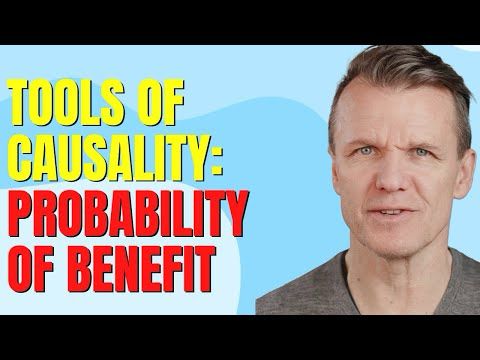
We ask how many patients would get better with treatment but not without it.
youtu.be/ms4z2i7JzVY
We ask how many patients would get better with treatment but not without it.
youtu.be/ms4z2i7JzVY

We ask how many patients would get better with treatment but not without it.
youtu.be/ms4z2i7JzVY




He reminds me of Mozart, who barely has time to write down all the revelations of causality pouring on him from above. 😊
He reminds me of Mozart, who barely has time to write down all the revelations of causality pouring on him from above. 😊
doi.org/10.9778/cmaj...

doi.org/10.9778/cmaj...
Pearl’s major contribution is grounding causality in materialism.
Pearl’s major contribution is grounding causality in materialism.
I just don't see how reasoning using words can be superior to reasoning using mathematical notation.
Pearl’s formulas easily describe RCT. But trialsts have a hard time to describe the estimand of their experiment.
I just don't see how reasoning using words can be superior to reasoning using mathematical notation.
Pearl’s formulas easily describe RCT. But trialsts have a hard time to describe the estimand of their experiment.
And! and your reasoning ‘it’s in the design’ is not reflected in your notation, right?
And! and your reasoning ‘it’s in the design’ is not reflected in your notation, right?
circumference, or for a value that
outcome variable would assume in unit u, if it were assigned to a treatment group regardless of any factors that might influence treatment assignment.
circumference, or for a value that
outcome variable would assume in unit u, if it were assigned to a treatment group regardless of any factors that might influence treatment assignment.
A denier of causal relationship btw tobacco smoking and lung cancer? yet ‘seeing’ causality btw race and the quality of ‘human stock’? Btw ‘high intellectual calibre’ of parents and their offsprings? Inverse link btw ‘fertility’ and ‘achievement’ of most valuable classes?

A denier of causal relationship btw tobacco smoking and lung cancer? yet ‘seeing’ causality btw race and the quality of ‘human stock’? Btw ‘high intellectual calibre’ of parents and their offsprings? Inverse link btw ‘fertility’ and ‘achievement’ of most valuable classes?
Credo quia absurdum
Credo quia absurdum
It comes from reasoning.
Unless, of course, the High Priests of EBM Pyramid deny us mere mortals the ability to think.

It comes from reasoning.
Unless, of course, the High Priests of EBM Pyramid deny us mere mortals the ability to think.
An RCT’s output, vaunted as assumption-free, are in fact not falsifiable. There is nothing to falsify.
That what makes EBM Priests so pompous: they present infallible evidence.😂

An RCT’s output, vaunted as assumption-free, are in fact not falsifiable. There is nothing to falsify.
That what makes EBM Priests so pompous: they present infallible evidence.😂
The PO notation is not needed to understand the counterfactual nature of the question that a randomized experiment purports to address.
The notation of Pearl’s First Principle would suffice.
The PO notation is not needed to understand the counterfactual nature of the question that a randomized experiment purports to address.
The notation of Pearl’s First Principle would suffice.
A tourist at the Louvre looks at La Gioconda and declares: 'I don't like it!' The curator nearby responds: 'Oh, she's seen so many people over the centuries that nowadays she decides who gets to like her.'
A tourist at the Louvre looks at La Gioconda and declares: 'I don't like it!' The curator nearby responds: 'Oh, she's seen so many people over the centuries that nowadays she decides who gets to like her.'

Here’s the probability of benefit (survival if treated early, mortality if not) estimated empirically.
Each bar shows the range of its possible values.

Here’s the probability of benefit (survival if treated early, mortality if not) estimated empirically.
Each bar shows the range of its possible values.

ie, the joint probability of opposing counterfactuals
P(Y_1=1 & Y_0=0)
equals the difference of marginal probability P(Y_1=1) and, wait for it, P(Y_0=1)
ie, the joint probability of opposing counterfactuals
P(Y_1=1 & Y_0=0)
equals the difference of marginal probability P(Y_1=1) and, wait for it, P(Y_0=1)



